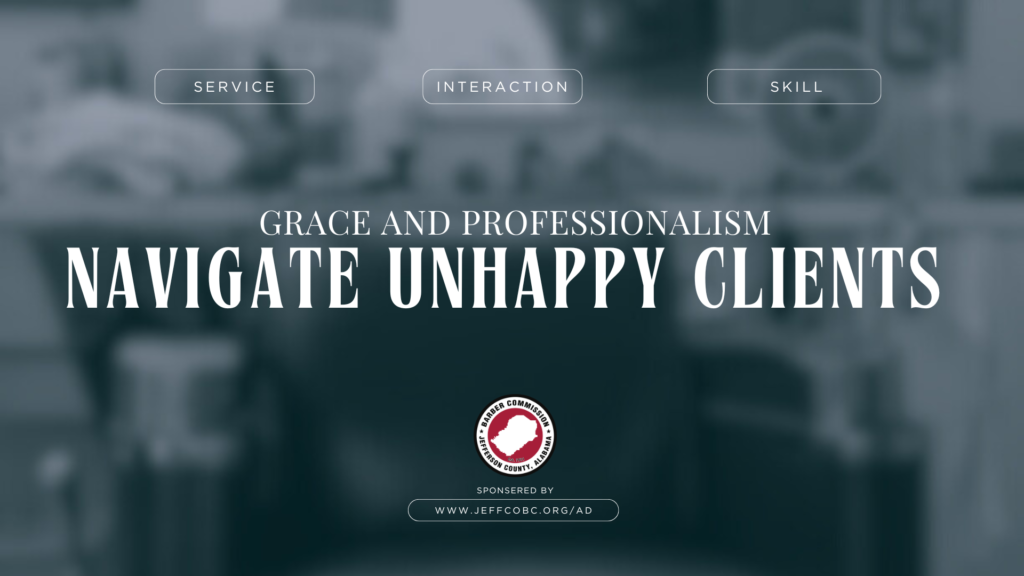
Estimated Read Time: 6 to 8 minutes.
In the world of barbering, every cut, trim, and style is a testament to your craft. You wake up early, stay late, and pour your heart into each client interaction. Your scissors are more than tools—they’re extensions of your artistry, precision, and care. Yet, despite your unwavering dedication, the truth remains: at some point, you will face an unhappy client.
This inevitability isn’t a reflection of your skill or commitment. It’s the byproduct of a people-centered profession, one that intertwines artistry with the unpredictable nature of human emotions. Barbering is a dance of connection—most days, it’s beautiful and harmonious. But occasionally, the rhythm falters, and you find yourself at odds with a unsatisfied client.
How you respond in these moments defines not only your professional reputation but also your resilience and character. Navigating these interactions with grace is both an art and a skill, one that can elevate you from being a good barber to a great one.
Here’s a nuanced exploration of how to handle these challenging moments, ensuring you emerge with dignity, professionalism, and perhaps even a stronger client relationship.
The Power of Grace Under Pressure
When faced with a disgruntled client, your initial reaction sets the tone for everything that follows. While frustration or defensiveness may tempt you, the most effective response is to remain calm. Anger fuels anger, but composure disarms it. The loudest voice in the room rarely wins; instead, the steady, measured response is what leaves a lasting impression.
Calmness isn’t about passivity. It’s about retaining control—not just of the situation but also of your emotions. You’re in a place of business, and your response reflects not just on you but on your establishment. Clients may forget the specifics of a disagreement, but they’ll always remember how you made them feel. Maintaining calm signals professionalism, and that’s an unshakable foundation upon which to build your resolution.
Detaching from the Personal Sting
When criticism is directed your way, the natural response is to internalize it. But the dissatisfaction of a client isn’t necessarily a referendum on your worth or abilities. It’s vital to draw a clear line between personal and professional. This separation allows you to approach the situation objectively, focusing on the issue at hand rather than letting emotions cloud your judgment.
Sometimes, a client’s dissatisfaction is rooted in circumstances beyond your control—a bad day, a miscommunication, or unrealistic expectations. Recognizing that their mood or behavior isn’t a direct attack can free you to address their concerns with clarity and empathy.
When Mistakes Happen, Accountability is Key
There’s no way around it: mistakes happen. Even the most seasoned barbers occasionally misstep. Perhaps a fade is too high, a cut too short, or a consultation misaligned with the client’s vision. In these moments, your response matters more than the mistake itself. Owning up to errors with humility and transparency demonstrates integrity.
Acknowledgment is powerful. A simple, “I see where I went wrong, and I’m committed to fixing it,” can diffuse tension and rebuild trust. Avoid the temptation to shift blame or minimize their concerns. Instead, focus on solutions. Whether it’s offering a complimentary fix or adjusting your approach for future appointments, showing that you value their satisfaction turns a negative experience into an opportunity for growth.
The Subtle Art of Sympathy
Sympathy doesn’t require you to shoulder undue blame or compromise your principles. Instead, it’s about validating your client’s feelings and showing that their concerns matter. A listening ear, paired with a genuine acknowledgment of their frustration, can work wonders.
At the same time, boundaries are essential. While you should be empathetic, avoid bending so far that you sacrifice your professional standards. It’s a delicate balance—one that requires you to remain firm in your expertise while demonstrating a willingness to accommodate reasonable requests.
Every Experience is a Lesson in Disguise
Each unhappy client interaction is a case study in improvement. Whether you manage to salvage the relationship or part ways, there’s wisdom to be gleaned. Reflection is your greatest ally. Analyze the situation: what triggered the dissatisfaction? Was it preventable? Did your response escalate or de-escalate the tension?
Growth stems from these insights. Adjust your consultations to clarify expectations. Sharpen your communication skills to ensure mutual understanding. Every difficult client is an opportunity to refine your craft, both technically and interpersonally.
Thoughtful Follow-Up as a Game-Changer
In certain scenarios, your job doesn’t end when the client leaves your chair. A thoughtful follow-up can cement your commitment to their satisfaction. This isn’t about over-apologizing or groveling; it’s about demonstrating a proactive investment in their experience.
A simple message or call—“I just wanted to check in to see how you’re feeling about your haircut now”—can transform a disgruntled client into a loyal one. It shows you care beyond the transactional nature of the appointment. For those who value personal connection, this extra step speaks volumes.
The Ultimate Test of Professionalism
Handling unhappy clients is never easy, but it’s an inevitable part of the journey. These moments test your patience, adaptability, and grace under pressure. More importantly, they’re an opportunity to showcase your commitment to your craft and your clients.
Barbering isn’t just about scissors and clippers; it’s about building relationships. And like any relationship, there will be ups and downs. Your ability to weather the storm with professionalism and kindness defines your legacy—not just as a barber but as a person.
In this people-focused profession, challenges with clients aren’t pitfalls; they’re stepping stones. Each interaction, no matter how difficult, is a chance to grow. Because at the heart of barbering isn’t just skill—it’s connection. And with the right mindset, even the most unhappy client can leave your chair with a newfound respect for your craft and character.


